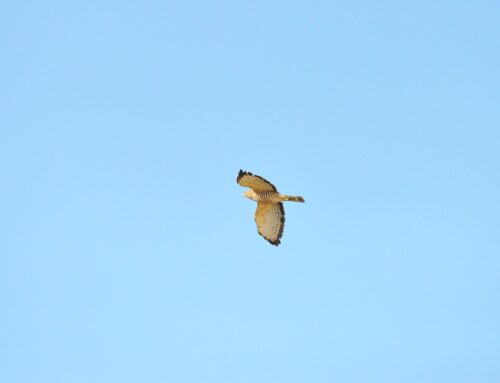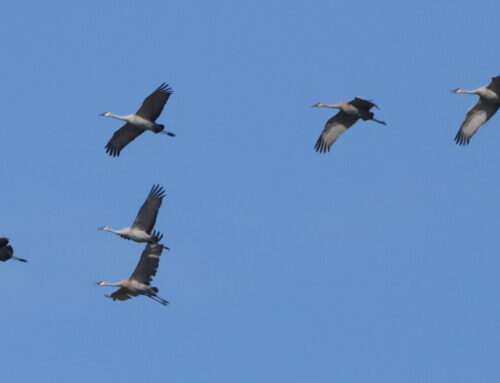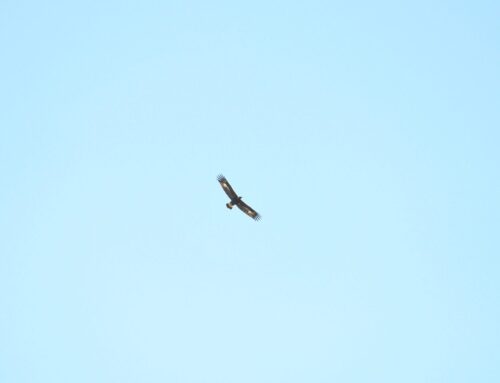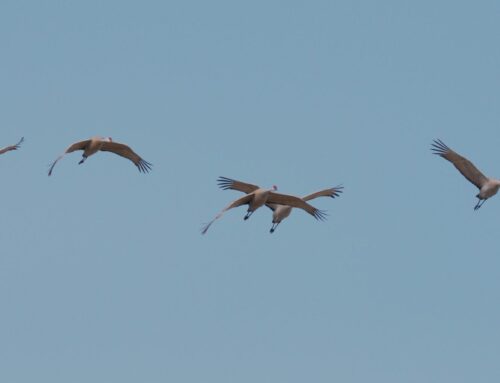Some days, the most peaceful moments of the waterbird count are about ten minutes before it actually starts. I like to arrive at the shack a little early: collect the first weather data, scan the lake and beach for resting birds–ease into things, you know. When the sun edges up over High Hills, time starts rolling, more birds start flying, and I start counting. On a busy day–a good day–a fun chaos quickly comes about: lines of scoters scoot around the Point; high above the horizon, a scaup flock flashes by, to be sorted for a tagalong Redhead. Warblers make high forays directly overhead–now, we’ve passed the season where all are Yellow-rumps. Sometimes on a busy morning, I am envious of an American Woodcock’s 360-degree vision.
Yesterday, May 14th, was a fine example of one of these good days. At 6:50 a.m., I looked south down the lake and realized the line of Bonaparte’s Gulls had no clear end. (The day’s total ended up at 493.) It was not just the Bonaparte’s, either! There was also good movement of Long-tailed Ducks (87) and both Common (169) and Red-throated (29) Loons. Occasionally, those of us at the Point were startled by the loud rush of wings: we’d look up to see the Blue Jay flock–that day estimated at 600–diving in unison for the trees like firework shrapnel.
On days like these, you walk away from the Point focusing mostly on the number of birds you tallied for the Count. (Yesterday, that was 1,822, most of them from the first three hours.) You are satisfied, certainly, but more from the rush of snagging the fast flyers than for appreciating the essence of any one bird. There’s no time for that. Bonaparte’s Gulls are dainty, ternlike in flight with sharp black hoods, but when I see a flock of Bonaparte’s, I am focused more on finding a dark underwing, something that would be attached to a rare Little Gull. While I may see hundreds of birds in a minute, it is unusual I spend a minute looking at one bird. There are many birds that need to be seen.
Yesterday evening, I returned to the Point and walked on past the Waterbird Shack out to the beach. Superior was tranquil; a Common Loon floated near shore. Jerry, a visiting birder from the Lower Peninsula, was already posted up on the Point. His scope was pointed away from the lake. I found this curious. As it turns out, though, his scope was trained on two Hudsonian Godwits resting in the pond. This species nests on the tundra, winters in Tierra del Fuego–and is quite rare in Michigan, especially in spring. Godwits are svelte and leggy–knockouts among the shorebirds. These were the first I had seen in breeding plumage, so I did what one should: enjoyed the godwits for the better part of two hours. It was the perfect comedown from a fast-paced day.
For this fourth week of the Waterbird Count, we’re starting to phase out most duck species (with the exception of White-winged and Surf Scoters and Long-tailed Ducks, which should be peaking soon). We are, however, adding new shorebird species each day. Long-billed Dowitcher (May 9) and Willet (May 14) are some of the highlights in regard to species; Least Sandpipers, both yellowlegs, Short-billed Dowitcher, and Solitary Sandpiper were seen most days this week. Both Red-throated and Common Loons continue to move through in good numbers, and I hope we have another big (bigger?) Bonaparte’s flight in store in the very near future. A passerine highlight observed from the Waterbird Count was a flyover flock of 49 Evening Grosbeaks on May 13.
–Alison Vilag, Spring 2019 WPBO Waterbird Counter
Featured Photo: One of the two Hudsonian Godwits at WPBO on May 14. Alison Vilag photo.







